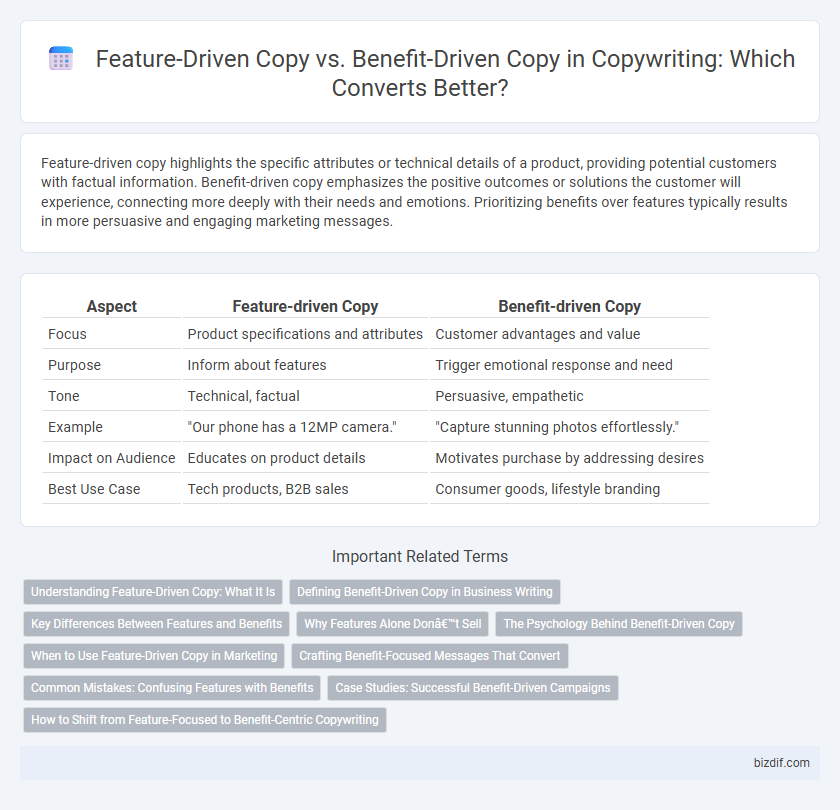Feature-driven copy highlights the specific attributes or technical details of a product, providing potential customers with factual information. Benefit-driven copy emphasizes the positive outcomes or solutions the customer will experience, connecting more deeply with their needs and emotions. Prioritizing benefits over features typically results in more persuasive and engaging marketing messages.
Table of Comparison
| Aspect | Feature-driven Copy | Benefit-driven Copy |
|---|---|---|
| Focus | Product specifications and attributes | Customer advantages and value |
| Purpose | Inform about features | Trigger emotional response and need |
| Tone | Technical, factual | Persuasive, empathetic |
| Example | "Our phone has a 12MP camera." | "Capture stunning photos effortlessly." |
| Impact on Audience | Educates on product details | Motivates purchase by addressing desires |
| Best Use Case | Tech products, B2B sales | Consumer goods, lifestyle branding |
Understanding Feature-Driven Copy: What It Is
Feature-driven copy highlights specific attributes, functions, or specifications of a product or service, providing detailed information that informs potential customers about what the offering includes. It focuses on tangible aspects such as size, color, technology, or materials, which appeal to buyers seeking explicit product knowledge. This approach is effective for audiences who prioritize technical details or need clear evidence of capabilities before making a decision.
Defining Benefit-Driven Copy in Business Writing
Benefit-driven copy in business writing emphasizes the direct value and advantages a product or service offers to the customer, highlighting how it solves problems or improves their situation. This approach focuses on customer needs and desires, creating emotional connections that drive engagement and conversions. By shifting the message from features to tangible outcomes, benefit-driven copy enhances relevance and motivates purchase decisions effectively.
Key Differences Between Features and Benefits
Feature-driven copy emphasizes the specific attributes and technical details of a product, such as size, material, or functionality, to inform potential customers. Benefit-driven copy highlights how those features translate into tangible advantages, like saving time, improving comfort, or increasing productivity, that directly address customer needs and desires. Focusing on benefits connects emotionally with the audience, making the message more persuasive and motivating purchase decisions.
Why Features Alone Don’t Sell
Focusing solely on product features limits customer engagement by neglecting the emotional and practical benefits that resonate with buyers' needs and desires. Consumers are more compelled by clear explanations of how a feature improves their life, solves a problem, or delivers value, making benefit-driven copy more persuasive. Feature-driven copy often fails to create a connection or sense of urgency, reducing overall conversion rates in marketing campaigns.
The Psychology Behind Benefit-Driven Copy
Benefit-driven copy leverages the psychological principle of value perception by addressing the reader's personal needs and emotions, making the product's advantages feel directly relevant and desirable. This approach taps into motivation and decision-making processes, highlighting how features translate into meaningful improvements in the user's life. Psychological triggers such as anticipation, trust, and emotional connection are activated through benefit-driven messaging, increasing engagement and the likelihood of conversion.
When to Use Feature-Driven Copy in Marketing
Feature-driven copy excels when marketing technical products or services aimed at a knowledgeable audience seeking specific details, such as software developers or engineers. It provides clarity by highlighting measurable attributes like processing speed, memory capacity, or compliance standards, enabling informed decision-making. Use feature-driven copy during product launches or updates where detailed specifications differentiate the offering from competitors.
Crafting Benefit-Focused Messages That Convert
Benefit-driven copy emphasizes how a product or service improves the customer's life, highlighting emotional and practical advantages that resonate deeply with the audience. Crafting messages centered on benefits rather than features connects with the reader's desires and pain points, driving higher engagement and conversion rates. Effective benefit-focused copy transforms technical details into clear, compelling reasons that inspire action.
Common Mistakes: Confusing Features with Benefits
Confusing features with benefits is a common mistake in copywriting that can weaken the impact of sales messages and reduce customer engagement. Features describe the product's attributes or specifications, while benefits explain how those features solve problems or improve the customer's life. Effective benefit-driven copy emphasizes outcomes and emotional value, making it clearer why the product matters to the consumer.
Case Studies: Successful Benefit-Driven Campaigns
Benefit-driven copy outperforms feature-driven copy by directly addressing customer needs and emotions, as demonstrated in case studies like Apple's "Get a Mac" campaign, which highlighted user benefits over technical specifications. Research shows campaigns focusing on benefits increase conversion rates by up to 30%, emphasizing the importance of relatable, value-centric messaging. Brands leveraging this strategy consistently see higher engagement, brand loyalty, and sales growth, proving the effectiveness of benefit-driven copy in real-world marketing scenarios.
How to Shift from Feature-Focused to Benefit-Centric Copywriting
Shifting from feature-focused to benefit-centric copywriting involves translating product features into clear, customer-oriented advantages that address specific needs or pain points. Identify the emotional and practical outcomes your audience desires, then craft messages that highlight how those features deliver tangible improvements in their lives. Emphasizing benefits over features creates more persuasive, engaging copy that drives higher conversion rates.
Feature-driven Copy vs Benefit-driven Copy Infographic

 bizdif.com
bizdif.com